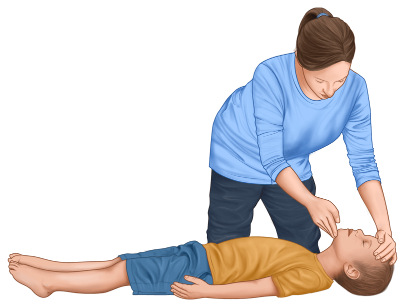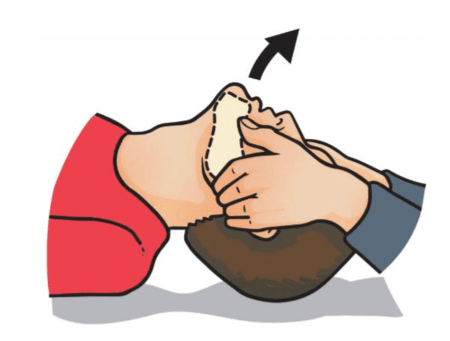4.3 A – Airway (Infants & Children)
Important Note
- Laypersons should perform hands-only CPR unless trained and willing to give rescue breaths.
- Healthcare Providers (HCPs) must follow full BLS protocol, including airway management and rescue breathing.
Opening the Airway
Before delivering breaths or checking for normal breathing, the airway must be opened. Use an airway maneuver appropriate for the situation and patient condition.
Head-Tilt/Chin-Lift (No Suspected Trauma)
The head-tilt/chin-lift is the standard method for opening the airway when no spinal injury is suspected.
Head Tilt–Chin Lift Maneuver
×
Head Tilt–Chin Lift Maneuver
 © FAW Training Solutions – All rights reserved
© FAW Training Solutions – All rights reserved
×

Head Tilt–Chin Lift Maneuver

© FAW Training Solutions – All rights reserved
- Place one hand on the victim’s forehead and gently tilt the head back.
- Use two fingers of the other hand to lift the chin, avoiding soft tissue under the jaw.
Jaw-Thrust Maneuver (Suspected Trauma)
If spinal injury is suspected, use the jaw-thrust maneuver to minimize neck movement while opening the airway.
Jaw-Thrust for Pediatric Patients
×
Jaw-Thrust for Pediatric Patients
 © FAW Training Solutions – All rights reserved
© FAW Training Solutions – All rights reserved
×

Jaw-Thrust for Pediatric Patients

© FAW Training Solutions – All rights reserved
- Position yourself at the top of the victim’s head.
- Place hands on both sides of the head, elbows on the surface.
- Use your fingers to lift the angles of the jaw forward without tilting the head.
Airway Positioning for Ventilation
Proper airway positioning is critical before providing any rescue breaths or ventilations, whether using a barrier device or a bag-mask system. Ensure the head and jaw remain aligned and open to allow airflow.